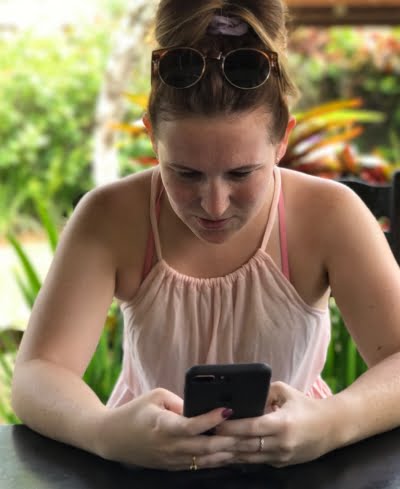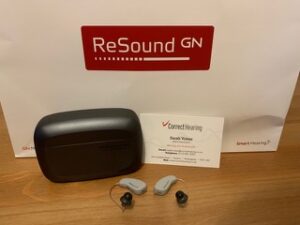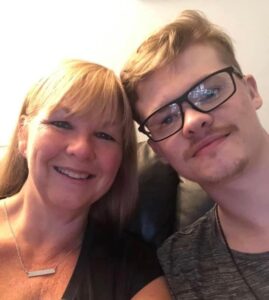San Francisco in November was an amazing experience, not just because I got to speak in Silicon Valley to some of the very top people in digital at Qcon I also got to re-visit my friends in the Accessibility Team at Apple Cupertino and I got to learn so much more.
I did a short informal talk about how and what accessibility features I use to some of the team, some I have met before and to a few new faces, we also discussed the new apple accessibility website.
I was able to speak about features I like, things I don’t and to pass on some great ideas from those around me, in the hope we can all do our bit to make things even better not just for the Usher Syndrome community but for everybody. If it works for minority groups it will work for the majority.
We then had a great questions and answers session. I love this part of my work, the more curious people are the better the understanding of need and the better result for the end user.
Apple products have enabled me to do so much so far. I am proud to be a small voice that gets listened to and am very grateful of the time spent with the team in Cupertino.
I was delighted to speak in great detail about the importance of ‘iPhone ready’ hearing aids and what that can mean to the deafblind, deaf, hearing impaired, hard of hearing – whatever term used, this connectivity is fantastic.
Forty four different types of hearing aid now ‘work’ with iPhone which is awesome. The one question I didn’t ask and which I wish I had is how many of the forty four are also ‘Applewatch ready’ as that really is the icing on the cake for the deafblind, with it’s prominent haptic abilities (vibration alerts on the wrist) and what for me make life a little safer and are very reassuring. I love the fact my Linx2 have direct connectivity to all of my apple products including applewatch.
This whole conversation really got me thinking about how amazing my hearing aids really are having direct that connectivity and what it all means to me.
I think knowing just how much I benefit from these things makes me feel really frustrated for the many people I know who could also benefit as much from my set up / toolkit.
The more I looked at the list of forty four the more annoyed I became.
The main reason being, the number one brand provided by NHS England does not have even one model, yes ‘NOT ONE MODEL’ on that list of forty four meaning millions and millions are missing out not just on best technology but on enablement and inclusion to carry out so much more than these now very outdated and out performed hearing aids.
Neck loops and faffing around are simply not good enough anymore, particularly as incredible assistive technology exists with built in connectivity and has done so for many years now.
Neck loops are fiddly and easily misplaced by the deafblind. Many don’t offer direct connectivity and are anything but inclusive and most have to self fund these extras too, also radio aids to assist with hearing in more challenging situations like meetings, classrooms, offices and the various other places not environmentally friendly for hearing aids, more cost and often to the individual.
Even with these things in place it is often not enough and then comes more expense for Government Services (Access to Work) who will need to fund STTR each and every time to enable accessibility.
How complicated is this system?
An up to date pair of smart hearing aids is the answer potentially saving a fortune.
NHS England need to think about ROI when providing hearing aids. Something even as simple as being able to use a telephone can give so much more in the way of enablement also employment, resulting in less unemployment, less mental health issues and most importantly less isolation.
There is no price for confidence so NHS ENGLAND isn’t it time you considered how far technology has come, consider all the things it can do and enable your patients.
It is a fact, confirmed to me by my deafblind trained social worker that all deafblind people should be issued with two pairs of hearing aids and two pairs of reading glasses because of the impact of dual sensory loss and the complete reliance on assistive technologies. This is detailed in my own personal Deafblind Assessment.
Sadly it seems few Health Authorities are aware or do they simply just ‘turn a blind eye or a deaf ear?’ Many in my position do not have two pairs of hearing aids and even worse often have hearing aids that are years old, denying them the opportunities to connect with modern enabling assistive technology, this really is not acceptable.
Perhaps when considering that each and every deafblind hearing aid user should have two pairs of hearing aids, instead provide one pair of modern smart aids enabling an exceptional hearing experience, also enabling locational sounds, access to speech near and far, to telephones, to access not just the sounds to stay safe but to understand them, to hear inside what is happening outside, to adjust and understand environment, also to enable control of hearing aids via apps, all of these things all assist with the challenges of deafblindness. Simply insist the hearing aids are insured.
I mentioned the add ons that dated hearing aids require like neckloops, radio aids. My hearing aids need neither, sound is streamed through the outstanding connectivity from iPhone to hearing aids and my iPhone even acts as a microphone.
I was told some months ago by an audiologist the reason people with deafblindness who choose to have cochlear implants will usually get funding for two at a cost far exceeding that of top of the range hearing aids is to enable locational sounds for safety – shouldn’t this be the same for hearing aid users?
Best access to sound for safety reasons should be all, not based on which type of hearing aid required. Safety is safety.
Outside can be a very frightening place when unable see or hear danger and not just for the deafblind person but also a potential danger to others.
I used standard issued NHS hearing aids from 18 months old until I was almost 21years old, I could access sound, I learnt to speak using those hearing aids and benefitted from all visual clues.
I was very typical of a deaf person, I coped ok. However since my Usher Syndrome diagnosis at 12 years old and being registered blind at 14 years old I felt more deaf, I struggled, particularly with tiredness. Back then I didn’t really know why. I was told ‘Usher Syndrome is exhausting!’.
Today it is obvious, I could no longer lipread very well or benefit from facial gesture, from body language or from the many visual clues deaf people use. I had to completely rely on my hearing aids and they just were not good enough.
Sadly there are many struggling along just like I did but what makes it even worse is they are now much more aware of what ‘Smart hearing aids” can offer they just cannot access them!
It is time for NHS England to not just be aware of the everyday challenges to those living with deafblindness, the real impact blindness has on somebody already deaf, how isolating a condition it is then it becomes clear to see that each person should have access to the very best in hearing aid technology.
Helen Keller’s quote from all those years ago ‘Blindness separates people from things, deafness separates from people’ is very true, however best technology can now not just ease isolation but enable inclusion.
I feel very privileged to have the very best in hearing aid technology, it enables me to be confident in my work. I also feel very passionate that others like myself should also have access to the best.
My smart hearing aids are more than just hearing aids they are literally my ‘Linx2Life’.
Smart hearing aids and apple products are accessibility tools for people like myself, they are not flashy gadgets they are essential for the everyday challenges faced.
I’d like this post to reach Goverment, to be read by NHS England, Access to Work, Social Workers working with the deafblind, Audiologists with deafblind patients, Occupational Therapists working with the deafblind and to anybody else I have missed in the care sector.
We have to make life inclusive.
Please share..
Read 25288 times


